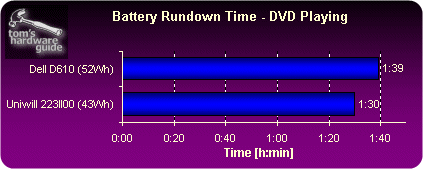Building Your Dream Notebook
Battery Life
Conclusion
As the benchmarks show, the THG DIY notebook can hold its own well in most disciplines against an off-the-shelf system. In terms of memory performance and 3D performance, Dell's Latitude D610 leads. But that is not surprising, because the Dell machine is based on the new Sonoma platform, which in the Latitude D610, works with fast DDR2 memory. In addition, the integrated GMA900 graphics core of the 915GM offers better 3D performance than its predecessor in the 855GME on which our DIY device is based.
As far as battery life is concerned, our DIY-system is not really what we would call a top performer. However, our results show that it can keep up with run of the mill notebooks , which offer nearly the same battery capacity (42Wh).
For whom, then, is a DIY device the "right" choice? Well, for anyone:
- who is interested primarily in the fun of choosing and building his or her own system;
- who does not have to watch every dollar;
- who is not afraid to service his or her own system.
However, another caveat is that the after-sales support and service of these systems is limited - or at least in Coboc's case - to a user forum and the download areas of barebook manufacturers. So to get updated drivers or a new BIOS, you can try your luck on the Websites of the barebook makers. But whether you'll find them there is doubtful at best. The warranty performance in Coboc's case is also rather scant.
Such a barebook can also be interesting if you have an "old" notebook at home in which the display, the motherboard or the case is broken. If you put it out to pasture and equip an appropriate barebook with the "old" but functional components, it can be an inexpensive - hence worthwhile - alternative to repairing it or buying a complete machine new.
Assembling a DIY notebook is also not a major challenge for anyone who is technically inclined. Most of the work is done before you actually build the system, when you decide which components satisfy and meet your needs and wants. Once you have scaled that wall, what remains to be done is relatively easy and does not take too much time.
However, as we found out with our system's display cover, a DIY will not absolutely meet the stability standards that you might expect. A shortcoming here and there, such as the repeatedly dimming display during battery operation, spoiled our enjoyment of the device. It is a complete mystery whether you can ever get a driver update or a new BIOS or order a replacement battery.
Get Tom's Hardware's best news and in-depth reviews, straight to your inbox.
Users who flinch at the idea of these shortcomings would thus be better off buying a machine off the shelf. In principle, you can at least be reasonably sure that an off-the-shelf notebook vendor includes a decent service and support package and can guarantee the supply of a replacement battery after the one-year period expires.

